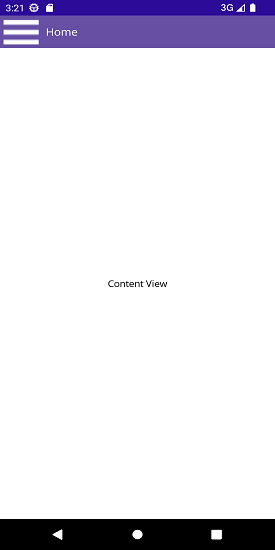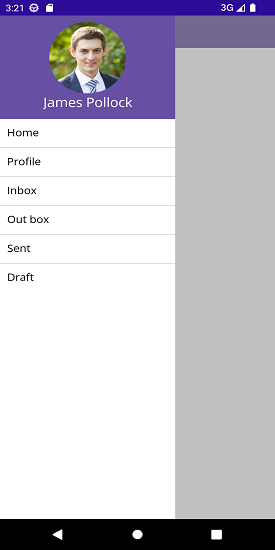Notice: After Volume 1 2025 (Mid of March 2025), feature enhancements for this control will no longer be available in the Syncfusion® package. Please switch to the Syncfusion® Toolkit for .NET MAUI for continued support. For a smooth transition, refer to this migration document.
Getting Started with .NET MAUI Navigation Drawer
24 Jul 202524 minutes to read
This section guides you through setting up and configuring a SfNavigationDrawer in your .NET MAUI application. Follow the steps below to add a basic Navigation Drawer to your project.
To quickly get started with the .NET MAUI Navigation Drawer, watch this video.
Prerequisites
Before proceeding, ensure the following are set up:
- Install .NET 8 SDK or later.
- Set up a .NET MAUI environment with Visual Studio 2022 (v17.3 or later).
Step 1: Create a new .NET MAUI project
- Go to File > New > Project and choose the .NET MAUI App template.
- Name the project and choose a location. Then, click Next.
- Select the .NET framework version and click Create.
Step 2: Install the Syncfusion® MAUI Navigation Drawer NuGet package
- In Solution Explorer, right-click the project and choose Manage NuGet Packages.
- Search for Syncfusion.Maui.NavigationDrawer and install the latest version.
- Ensure the necessary dependencies are installed correctly, and the project is restored.
Step 3: Register the handler
The Syncfusion.Maui.Core NuGet is a dependent package for all Syncfusion® controls in .NET MAUI. In the MauiProgram.cs file, register the handler for Syncfusion® core.
using Microsoft.Extensions.Logging;
using Syncfusion.Maui.Core.Hosting;
namespace NavigationDrawerGettingStarted
{
public static class MauiProgram
{
public static MauiApp CreateMauiApp()
{
var builder = MauiApp.CreateBuilder();
builder
.UseMauiApp<App>()
.ConfigureSyncfusionCore()
.ConfigureFonts(fonts =>
{
fonts.AddFont("OpenSans-Regular.ttf", "OpenSansRegular");
});
return builder.Build();
}
}
}Step 4: Add a basic Navigation Drawer
-
To initialize the control, import the Navigation Drawer namespace into your code.
-
Initialize SfNavigationDrawer.
<ContentPage
. . .
xmlns:navigationDrawer="clr-namespace:Syncfusion.Maui.NavigationDrawer;assembly=Syncfusion.Maui.NavigationDrawer">
<navigationDrawer:SfNavigationDrawer x:Name="navigationDrawer">
<navigationDrawer:SfNavigationDrawer.ContentView>
<Grid/>
</navigationDrawer:SfNavigationDrawer.ContentView>
</navigationDrawer:SfNavigationDrawer>
</ContentPage>using Syncfusion.Maui.NavigationDrawer;
namespace NavigationDrawerGettingStarted
{
public partial class MainPage : ContentPage
{
public MainPage()
{
InitializeComponent();
SfNavigationDrawer navigationDrawer = new SfNavigationDrawer();
Grid grid = new Grid();
navigationDrawer.ContentView = grid;
this.Content = navigationDrawer;
}
}
}Prerequisites
Before proceeding, ensure the following are set up:
- Install .NET 8 SDK or later.
- Set up a .NET MAUI environment with Visual Studio Code.
- Ensure that the .NET MAUI extension is installed and configured as described here.
Step 1: Create a new .NET MAUI project
- Open the command palette by pressing
Ctrl+Shift+Pand type .NET:New Project and enter. - Choose the .NET MAUI App template.
- Select the project location, type the project name and press Enter.
- Then choose Create project.
Step 2: Install the Syncfusion® MAUI Navigation Drawer NuGet package
- Press Ctrl + ` (backtick) to open the integrated terminal in Visual Studio Code.
- Ensure you’re in the project root directory where your .csproj file is located.
- Run the command
dotnet add package Syncfusion.Maui.NavigationDrawerto install the Syncfusion® .NET MAUI Navigation Drawer package. - To ensure all dependencies are installed, run
dotnet restore.
Step 3: Register the handler
The Syncfusion.Maui.Core NuGet is a dependent package for all Syncfusion® controls of .NET MAUI. In the MauiProgram.cs file, register the handler for Syncfusion® core.
using Microsoft.Extensions.Logging;
using Syncfusion.Maui.Core.Hosting;
namespace NavigationDrawerGettingStarted
{
public static class MauiProgram
{
public static MauiApp CreateMauiApp()
{
var builder = MauiApp.CreateBuilder();
builder
.UseMauiApp<App>()
.ConfigureSyncfusionCore()
.ConfigureFonts(fonts =>
{
fonts.AddFont("OpenSans-Regular.ttf", "OpenSansRegular");
});
return builder.Build();
}
}
}Step 4: Add a basic Navigation Drawer
-
To initialize the control, import the Navigation Drawer namespace into your code.
-
Initialize SfNavigationDrawer.
<ContentPage
. . .
xmlns:navigationDrawer="clr-namespace:Syncfusion.Maui.NavigationDrawer;assembly=Syncfusion.Maui.NavigationDrawer">
<navigationDrawer:SfNavigationDrawer x:Name="navigationDrawer">
<navigationDrawer:SfNavigationDrawer.ContentView>
<Grid/>
</navigationDrawer:SfNavigationDrawer.ContentView>
</navigationDrawer:SfNavigationDrawer>
</ContentPage>using Syncfusion.Maui.NavigationDrawer;
namespace NavigationDrawerGettingStarted
{
public partial class MainPage : ContentPage
{
public MainPage()
{
InitializeComponent();
SfNavigationDrawer navigationDrawer = new SfNavigationDrawer();
Grid grid = new Grid();
navigationDrawer.ContentView = grid;
this.Content = navigationDrawer;
}
}
}Prerequisites
Before proceeding, ensure the following are set up:
- Ensure you have the latest version of JetBrains Rider.
- Install .NET 8 SDK or later.
- Make sure the MAUI workloads are installed and configured as described here.
Step 1: Create a new .NET MAUI project
- Go to File > New Solution, select .NET (C#) and choose the .NET MAUI App template.
- Enter the Project Name, Solution Name, and Location.
- Select the .NET framework version and click Create.
Step 2: Install the Syncfusion® MAUI Navigation Drawer NuGet package
- In Solution Explorer, right-click the project and choose Manage NuGet Packages.
- Search for Syncfusion.Maui.NavigationDrawer and install the latest version.
- Ensure the necessary dependencies are installed correctly, and the project is restored. If not, open the Terminal in Rider and manually run:
dotnet restore.
Step 3: Register the handler
The Syncfusion.Maui.Core NuGet is a dependent package for all Syncfusion® controls of .NET MAUI. In the MauiProgram.cs file, register the handler for Syncfusion® core.
using Microsoft.Extensions.Logging;
using Syncfusion.Maui.Core.Hosting;
namespace NavigationDrawerGettingStarted
{
public static class MauiProgram
{
public static MauiApp CreateMauiApp()
{
var builder = MauiApp.CreateBuilder();
builder
.UseMauiApp<App>()
.ConfigureSyncfusionCore()
.ConfigureFonts(fonts =>
{
fonts.AddFont("OpenSans-Regular.ttf", "OpenSansRegular");
});
return builder.Build();
}
}
}Step 4: Add a basic Navigation Drawer
-
To initialize the control, import the Navigation Drawer namespace into your code.
-
Initialize SfNavigationDrawer.
<ContentPage
. . .
xmlns:navigationDrawer="clr-namespace:Syncfusion.Maui.NavigationDrawer;assembly=Syncfusion.Maui.NavigationDrawer">
<navigationDrawer:SfNavigationDrawer x:Name="navigationDrawer">
<navigationDrawer:SfNavigationDrawer.ContentView>
<Grid/>
</navigationDrawer:SfNavigationDrawer.ContentView>
</navigationDrawer:SfNavigationDrawer>
</ContentPage>using Syncfusion.Maui.NavigationDrawer;
namespace NavigationDrawerGettingStarted
{
public partial class MainPage : ContentPage
{
public MainPage()
{
InitializeComponent();
SfNavigationDrawer navigationDrawer = new SfNavigationDrawer();
Grid grid = new Grid();
navigationDrawer.ContentView = grid;
this.Content = navigationDrawer;
}
}
}NOTE
It is mandatory to set ContentView for SfNavigationDrawer upon initializing.
Adjust drawer size
The default position of the navigation pane is on the left. Change the drawer width to 250 using the DrawerWidth property.
<navigationDrawer:SfNavigationDrawer x:Name="navigationDrawer">
<navigationDrawer:SfNavigationDrawer.DrawerSettings>
<navigationDrawer:DrawerSettings DrawerWidth="250"/>
</navigationDrawer:SfNavigationDrawer.DrawerSettings>
<navigationDrawer:SfNavigationDrawer.ContentView>
<Grid/>
</navigationDrawer:SfNavigationDrawer.ContentView>
</navigationDrawer:SfNavigationDrawer>using Syncfusion.Maui.NavigationDrawer;
namespace NavigationDrawerGettingStarted;
public partial class MainPage : ContentPage
{
public MainPage()
{
InitializeComponent();
SfNavigationDrawer navigationDrawer = new SfNavigationDrawer();
Grid grid = new Grid();
navigationDrawer.ContentView = grid;
navigationDrawer.DrawerSettings = new DrawerSettings()
{
DrawerWidth = 250,
};
this.Content = navigationDrawer;
}
}NOTE
To change the side of the navigation pane, utilize the Position property. Adjust the drawer height in the Top and Bottom positions using the DrawerHeight property.
Add hamburger menu for toggling drawer
Create an ImageButton and set the required image to the Source property. Ensure the image is placed in the Resources/Images directory. Subscribe to the Clicked event of the button and invoke the ToggleDrawer() method to toggle the drawer. Properly align the layout of ContentView to position the hamburger icon at the top left, as demonstrated in the following code.
<navigationDrawer:SfNavigationDrawer x:Name="navigationDrawer">
<navigationDrawer:SfNavigationDrawer.DrawerSettings>
<navigationDrawer:DrawerSettings DrawerWidth="250"/>
</navigationDrawer:SfNavigationDrawer.DrawerSettings>
<navigationDrawer:SfNavigationDrawer.ContentView>
<Grid x:Name="mainContentView"
BackgroundColor="White" RowDefinitions="Auto,*">
<HorizontalStackLayout BackgroundColor="#6750A4" Spacing="10" Padding="5,0,0,0">
<ImageButton x:Name="hamburgerButton"
HeightRequest="50"
WidthRequest="50"
HorizontalOptions="Start"
Source="hamburgericon.png"
BackgroundColor="#6750A4"
Clicked="hamburgerButton_Clicked"/>
<Label x:Name="headerLabel"
HeightRequest="50"
HorizontalTextAlignment="Center"
VerticalTextAlignment="Center"
Text="Home" FontSize="16"
TextColor="White"
BackgroundColor="#6750A4"/>
</HorizontalStackLayout>
<Label Grid.Row="1"
x:Name="contentLabel"
VerticalOptions="Center"
HorizontalOptions="Center"
Text="Content View"
FontSize="14"
TextColor="Black"/>
</Grid>
</navigationDrawer:SfNavigationDrawer.ContentView>
</navigationDrawer:SfNavigationDrawer>namespace NavigationDrawerGettingStarted;
public partial class MainPage : ContentPage
{
SfNavigationDrawer navigationDrawer;
Label contentLabel;
public MainPage()
{
InitializeComponent();
navigationDrawer = new SfNavigationDrawer();
Grid grid = new Grid()
{
RowDefinitions =
{
new RowDefinition {Height=new GridLength(1,GridUnitType.Auto)},
new RowDefinition(),
},
BackgroundColor = Colors.White,
};
HorizontalStackLayout layout = new HorizontalStackLayout()
{
BackgroundColor = Color.FromArgb("#6750A4"),
Spacing = 10,
Padding = new Thickness(5,0,0,0),
};
var hamburgerButton = new ImageButton
{
HeightRequest = 50,
WidthRequest = 50,
HorizontalOptions = LayoutOptions.Start,
BackgroundColor = Color.FromArgb("#6750A4"),
Source = "hamburgericon.png",
};
hamburgerButton.Clicked += hamburgerButton_Clicked;
var label = new Label
{
HeightRequest = 50,
HorizontalTextAlignment = TextAlignment.Center,
VerticalTextAlignment = TextAlignment.Center,
Text = "Home",
FontSize = 16,
TextColor = Colors.White,
BackgroundColor = Color.FromArgb("#6750A4")
};
layout.Children.Add(hamburgerButton);
layout.Children.Add(label);
contentLabel = new Label
{
HorizontalOptions = LayoutOptions.Center,
VerticalOptions = LayoutOptions.Center,
Text = "Content View",
FontSize = 14,
TextColor = Colors.Black
};
grid.SetRow(layout, 0);
grid.SetRow(contentLabel, 1);
grid.Children.Add(layout);
grid.Children.Add(contentLabel);
navigationDrawer.ContentView = grid;
navigationDrawer.DrawerSettings = new DrawerSettings()
{
DrawerWidth = 250,
};
this.Content = navigationDrawer;
}
}private void hamburgerButton_Clicked(object sender, EventArgs e)
{
navigationDrawer.ToggleDrawer();
}
Set CollectionView as DrawerContentView
Create a CollectionView with items and set it as DrawerContentView.
<navigationDrawer:SfNavigationDrawer x:Name="navigationDrawer">
<navigationDrawer:SfNavigationDrawer.DrawerSettings>
<navigationDrawer:DrawerSettings DrawerWidth="250"
DrawerHeaderHeight="160">
<navigationDrawer:DrawerSettings.DrawerHeaderView>
<Grid BackgroundColor="#6750A4" RowDefinitions="120,40">
<Image Source="user.png"
HeightRequest="110"
Margin="0,10,0,0"
BackgroundColor="#6750A4"
VerticalOptions="Center"
HorizontalOptions="Center"/>
<Label Text="James Pollock"
Grid.Row="1"
HorizontalTextAlignment="Center"
HorizontalOptions="Center"
FontSize="20"
TextColor="White"/>
</Grid>
</navigationDrawer:DrawerSettings.DrawerHeaderView>
<navigationDrawer:DrawerSettings.DrawerContentView>
<CollectionView x:Name="collectionView" SelectionMode="Single"
SelectionChanged="collectionView_SelectionChanged">
<CollectionView.ItemsSource>
<x:Array Type="{x:Type x:String}">
<x:String>Home</x:String>
<x:String>Profile</x:String>
<x:String>Inbox</x:String>
<x:String>Outbox</x:String>
<x:String>Sent</x:String>
<x:String>Draft</x:String>
</x:Array>
</CollectionView.ItemsSource>
<CollectionView.ItemTemplate>
<DataTemplate>
<VerticalStackLayout HeightRequest="40">
<Label Margin="10,7,0,0"
Text="{Binding}"
FontSize="16"
TextColor="Black"/>
</VerticalStackLayout>
</DataTemplate>
</CollectionView.ItemTemplate>
</CollectionView>
</navigationDrawer:DrawerSettings.DrawerContentView>
</navigationDrawer:DrawerSettings>
</navigationDrawer:SfNavigationDrawer.DrawerSettings>
<navigationDrawer:SfNavigationDrawer.ContentView>
<Grid x:Name="mainContentView"
BackgroundColor="White" RowDefinitions="Auto,*">
<HorizontalStackLayout BackgroundColor="#6750A4" Spacing="10" Padding="5,0,0,0">
<ImageButton x:Name="hamburgerButton"
HeightRequest="50"
WidthRequest="50"
HorizontalOptions="Start"
Source="hamburgericon.png"
BackgroundColor="#6750A4"
Clicked="hamburgerButton_Clicked"/>
<Label x:Name="headerLabel"
HeightRequest="50"
HorizontalTextAlignment="Center"
VerticalTextAlignment="Center"
Text="Home" FontSize="16"
TextColor="White"
BackgroundColor="#6750A4"/>
</HorizontalStackLayout>
<Label Grid.Row="1"
x:Name="contentLabel"
VerticalOptions="Center"
HorizontalOptions="Center"
Text="Content View"
FontSize="14"
TextColor="Black"/>
</Grid>
</navigationDrawer:SfNavigationDrawer.ContentView>
</navigationDrawer:SfNavigationDrawer>namespace NavigationDrawerGettingStarted;
public partial class MainPage : ContentPage
{
SfNavigationDrawer navigationDrawer;
Label headerLabel;
Label contentLabel;
CollectionView collectionView;
public MainPage()
{
InitializeComponent();
// Drawer Header View
var drawerHeader = new Grid
{
BackgroundColor = Color.FromArgb("#6750A4"),
RowDefinitions = new RowDefinitionCollection
{
new RowDefinition { Height = 120 },
new RowDefinition { Height = 40 }
}
};
drawerHeader.Add(new Image
{
Source = "user.png",
HeightRequest = 110,
Margin = new Thickness(0, 10, 0, 0),
BackgroundColor = Color.FromArgb("#6750A4"),
VerticalOptions = LayoutOptions.Center,
HorizontalOptions = LayoutOptions.Center
});
drawerHeader.Add(new Label
{
Text = "James Pollock",
FontSize = 20,
TextColor = Colors.White,
HorizontalTextAlignment = TextAlignment.Center,
HorizontalOptions = LayoutOptions.Center
}, 0, 1);
// Drawer Content View
collectionView = new CollectionView
{
SelectionMode = SelectionMode.Single,
ItemsSource = new string[] { "Home", "Profile", "Inbox", "Outbox", "Sent", "Draft" },
ItemTemplate = new DataTemplate(() =>
{
var label = new Label
{
Margin = new Thickness(10, 7, 0, 0),
FontSize = 16,
TextColor = Colors.Black
};
label.SetBinding(Label.TextProperty, ".");
return new VerticalStackLayout
{
HeightRequest = 40,
Children = { label }
};
})
};
collectionView.SelectionChanged += collectionView_SelectionChanged;
var drawerSettings = new DrawerSettings
{
DrawerWidth = 250,
DrawerHeaderHeight = 160,
DrawerHeaderView = drawerHeader,
DrawerContentView = collectionView
};
// Main Content View
headerLabel = new Label
{
Text = "Home",
FontSize = 16,
TextColor = Colors.White,
BackgroundColor = Color.FromArgb("#6750A4"),
HeightRequest = 50,
HorizontalTextAlignment = TextAlignment.Center,
VerticalTextAlignment = TextAlignment.Center
};
contentLabel = new Label
{
Text = "Content View",
FontSize = 14,
TextColor = Colors.Black,
VerticalOptions = LayoutOptions.Center,
HorizontalOptions = LayoutOptions.Center
};
var hamburgerButton = new ImageButton
{
Source = "hamburgericon.png",
HeightRequest = 50,
WidthRequest = 50,
BackgroundColor = Color.FromArgb("#6750A4"),
HorizontalOptions = LayoutOptions.Start
};
hamburgerButton.Clicked += hamburgerButton_Clicked;
var topBar = new HorizontalStackLayout
{
BackgroundColor = Color.FromArgb("#6750A4"),
Spacing = 10,
Padding = new Thickness(5, 0, 0, 0),
Children = { hamburgerButton, headerLabel }
};
var mainContent = new Grid
{
BackgroundColor = Colors.White,
RowDefinitions = new RowDefinitionCollection
{
new RowDefinition { Height = GridLength.Auto },
new RowDefinition { Height = GridLength.Star }
}
};
mainContent.Add(topBar);
mainContent.Add(contentLabel, 0, 1);
// Navigation Drawer
navigationDrawer = new SfNavigationDrawer
{
DrawerSettings = drawerSettings,
ContentView = mainContent
};
Content = navigationDrawer;
}
}private void hamburgerButton_Clicked(object sender, EventArgs e)
{
navigationDrawer.ToggleDrawer();
}
private void collectionView_SelectionChanged(object sender, SelectionChangedEventArgs e)
{
if (e.CurrentSelection.FirstOrDefault() is string selectedItem)
{
headerLabel.Text = selectedItem;
contentLabel.Text = $"{selectedItem} Content";
navigationDrawer.ToggleDrawer();
}
}
You can find the getting started sample from the GitHub link.